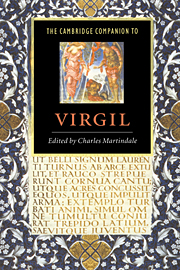Book contents
- Frontmatter
- Contents
- List of illustrations
- List of contributors
- Preface
- 1 Introduction: ‘The classic of all Europe’
- Part 1 Translation and reception
- 2 Virgil in English translation
- 3 Modern receptions and their interpretative implications
- 4 Aspects of Virgil's reception in antiquity
- 5 The Virgil commentary of Servius
- 6 Virgils, from Dante to Milton
- 7 Virgil in art
- Part 2 Genre and poetic career
- Part 3 Contexts of production
- Part 4 Contents and forms
- Dateline compiled by Genevieve Liveley
- List of works cited
- Index
- Plates
2 - Virgil in English translation
from Part 1 - Translation and reception
Published online by Cambridge University Press: 28 May 2006
- Frontmatter
- Contents
- List of illustrations
- List of contributors
- Preface
- 1 Introduction: ‘The classic of all Europe’
- Part 1 Translation and reception
- 2 Virgil in English translation
- 3 Modern receptions and their interpretative implications
- 4 Aspects of Virgil's reception in antiquity
- 5 The Virgil commentary of Servius
- 6 Virgils, from Dante to Milton
- 7 Virgil in art
- Part 2 Genre and poetic career
- Part 3 Contexts of production
- Part 4 Contents and forms
- Dateline compiled by Genevieve Liveley
- List of works cited
- Index
- Plates
Summary
'Virgil' does not just denote the 13,000 or so lines of verse which are now usually attributed to the poet who is believed to have lived between 70 and 19 BC: the word also connotes all the interpretations which have accreted around those lines over the past two thousand years. A study of English translations - over a more modest period of five hundred years - can help us to understand what kind of Virgil has become embedded in English culture. Someone who has taught us, or someone who has taught someone who has taught us, will have read and absorbed, say, Dryden's Virgil - and Dryden had read widely in earlier translations, and was read by almost all later translators. When we interpret we usually think that it is simply we alone who are doing the interpretation. But our language contains buried fragments of the past, and to know the origins of at least some of these fragments can enable us to realise that some of what we think of as being our own views come from dark corners of history. This chapter aims to show the genesis of two more or less irreconcilable tendencies in recent responses to Virgil. The first is the belief that Virgil is a poet of divided loyalties, whose poems cannot completely align themselves with the empire of Rome. The second is the very widespread view that a perfect translation of Virgil would be so accurate that its translator would be invisible. Both of these beliefs emerge, as we shall see, at very specific and surprisingly early periods. What also comes out of this survey, albeit partial, of Virgil in English translation is that Virgil has only rarely appealed to poets who enjoy the patronage of English monarchs. Most English translators of Virgil are anxious about their own standing, and usually they support losing political causes. Virgil tends to be adopted into English by poets who need the consolation of his authority or the sustaining dream of his imperial vision.
- Type
- Chapter
- Information
- The Cambridge Companion to Virgil , pp. 21 - 37Publisher: Cambridge University PressPrint publication year: 1997
- 15
- Cited by

